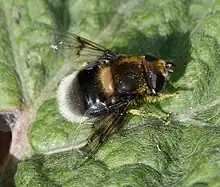Eristalis intricaria
Eristalis intricaria is a European species of hoverfly. It is a furry bee mimic, superficially resembling Merodon, though Merodon have all black leg tibiae, as opposed to partly yellow. E. intricaria is somewhat variable in colour pattern, and some attempts at naming varieties have been tentatively made. Flight time of adults in the UK are from March to September. It is generally widespread, but is seldom seen in large numbers. Habitat is woodland or marshland.
| Eristalis intricaria | |
|---|---|
_dorsal.jpg.webp) | |
| male | |
 | |
| female | |
| Scientific classification | |
| Kingdom: | |
| Phylum: | |
| Class: | |
| Order: | |
| Family: | |
| Subfamily: | |
| Tribe: | |
| Genus: | |
| Subgenus: | Eoseristalis |
| Species: | E. intricaria |
| Binomial name | |
| Eristalis intricaria | |
| Synonyms | |
_-_Flickr_-_S._Rae.jpg.webp)
Description
External images
For terms see Morphology of Diptera
Wing length 8·25–12 mm. Antennomere 3 brownish-black. Arista plumose on basal half. Squamulae greyish-black. Thorax and abdomen covered with long densely placed hairs, varying in colour from tawny (typical form) to black (var. furvus Verrall). Typical form dimorphic (male abdomen brownish-haired, female abdomen with blackish hairs, last tergite with white hairs).[3]
[4]
[5][6]
The male genitalia are figured by Hippa et al. (2001) [7] The larva is figured by Hartley (1961) [8]
Distribution
Palaearctic Fennoscandia, Iceland and the Faroes South to central Spain, montane in the southern limit of its range and absent from most of South Europe. Ireland East through North Europe and Central Europe, Alps, into Russia as far as East Siberia. [9][10]
Biology
The habitat is wetland; raised bog, fen, fen carr, poorly-drained deciduous forest and humid, seasonally-flooded grassland, boreal forests, taiga, montane tundra.[11] Flowers visited include white umbellifers yellow composites, Ranunculaceae, Armeria maritima, Cakile, Calluna vulgaris, Cirsium, Crataegus, Filipendula, Jasione, Ligustrum, Lythrum, Mentha, Polygonum cuspidatum, Prunus spinosa, Pyrus communis, Rhododendron, Rubus, Salix, Succisa.[12] The flight period is mid April to end August. The larvae occur in mud and fen peat beside water, in field drains, slurry and in cow dung on water-logged ground.
References
- Stubbs, Alan E.; Falk, Steven J. (1983). British Hoverflies: An Illustrated Identification Guide. British Entomological & Natural History Society. pp. 253, xvpp.
- Fauna Europaea
- Van Veen, M. (2004) Hoverflies of Northwest Europe: identification keys to the Syrphidae. 256pp. KNNV Publishing, Utrecht.addendum
- Van der Goot,V.S. (1981) De zweefvliegen van Noordwest - Europa en Europees Rusland, in het bijzonder van de Benelux. KNNV, Uitgave no.32: 275pp. Amsterdam.
- Bei-Bienko, G.Y. & Steyskal, G.C. (1988) Keys to the Insects of the European Part of the USSR, Volume V: Diptera and Siphonaptera, Part I. Amerind Publishing Co., New Delhi. ISBN 81-205-0080-6.
- Coe, R.L. (1953) Diptera: Syrphidae. Handbks.ident.Br.insects, 10(1): 1-98. R.ent.Soc.London. pdf
- Hippa, H., Nielsen, T.R. & van Steenis, J. (2001) The west Palaearctic species of the genus Eristalis Latreille (Diptera, Surphidae). Norw.J.Entomol., 48: 289-327.
- Hartley, J.C. (1961) A taxonomic account of the larvae of some British Syrphidae. Proc.zool.Soc.Lond.,136: 505-573.
- Fauna Europaea
- Peck, L.V. (1988) Syrphidae. In: Soos, A. & Papp, L. (eds.) Catalogue of Palaearctic Diptera, 8: 11-230. Akad.Kiado, Budapest.
- Speight, M.C.D. (2011). "Species accounts of European Syrphidae (Diptera)" (PDF). Syrph the Net, the database of European Syrphidae. 65: 285pp.
- de Buck, N. (1990) Bloembezoek en bestuivingsecologie van Zweefvliegen (Diptera, Syrphidae) in het bijzonder voor België. Doc.Trav. IRSNB, no.60, 1-167.